Happily Ever Becoming
The story of the Kaul Wildflower Garden is rooted in the ongoing dialogue between this special site and those who care for it
By Molly Hendry
WE ALL LOVE A GOOD BEFORE AND AFTER TALE, DON’T WE? THE ONES that end with a “happily ever after,” buttoned up and beautiful.
But today, we are inviting you into the middle of a story unfolding, an ongoing conversation between a garden and its gardeners. This is the story of the Kaul Wildflower Garden, a foray into the state of becoming, venturing into the time and space between the proverbial “before” and “after.” I’d like to ask you to don your gardening boots and suit up to get your hands dirty on this journey. Along the way there are going to be lots of studio sketches mixed with some handsaws and pickaxes as our team dives headfirst into restoring Kaul to its original design intent: to celebrate the diversity of Alabama’s native flora.
To really drop you into the middle of the story, it is best if you first join us for a volunteer workday. It’s one of those damp winter mornings, the kind that makes it feel as if the chill has sunk deep in your bones. I hear the clatter of the yellow trailer bumping down the road, returning for another load of brush that has been cleared from the eastern forest slope. Next to me are volunteers, saws in hand, moving stem by stem through the sea of Florida anise that has taken over the hillside, smothering almost everything in its wake. Although this prolific shrub is native, we know it has to be cleared to make way for our future vision of a restored oak-hickory-pine forest with a sparkling herbaceous forest floor. While we suspect that beneath the Florida anise is a world of spring ephemerals looking for space, we will have to wait to find out.
I take a minute to look around at the garden in its winter glory. As we have cleared layers of woody plants, craggy rocks are exposed, highlighting the curvy paths winding through the garden as far as you can see. This structural layer was established more than 50 years ago when the Depression-era sandstone rock quarry at the northern tip of Birmingham Botanical Gardens was chosen as the site for a wildflower garden. The effort was led by a passionate group of women with the vision to craft a garden that pays tribute to Alabama’s staggering diversity. Many of these women, including the garden’s namesake, Mrs. Bobbe Kaul, were vocal advocates for the preservation of wild places throughout our region.
The Conversation Begins
Our records from this period of the garden’s inception are filled with pictures of an older man dressed in khaki pants, thick-soled shoes, and fedora and often pointing toward rocks or a path edge. It doesn’t take much digging to piece together that this man is Zenon Schreiber, a Swiss horticulturist and landscape architect who made a name for himself designing rock gardens across the Northeast during his career. As soon as Mrs. Kaul saw one of Schreiber’s gardens in New Jersey, she knew he was the man for this challenge. And she was right, because not only was he a genius at selecting the plants to fit the site but also his magical touch with rock turned the rubble of the abandoned quarry into a garden masterpiece.

Bob Koons and Jim StJohn cut back spent foliage in the bog planting.
Schreiber had a long relationship with the garden over the course of 12 years, visiting the Gardens for weeks at a time, helping direct the on-site laying of paths, rockwork, and plantings. Even when he returned to New York, the ladies would mail him Polaroid pictures with captions about ongoing developments in the garden, and Schreiber would scribble notes in the margins and mail them back. From the start, each design move was a conversation.
While the strong bones of Schreiber’s rockwork and winding paths are largely still intact today, much has changed in Kaul over the course of five decades. The spatial composition that Schreiber worked within has shifted as trees have been lost, the collection has diversified, shrubs have matured, and surrounding areas have been developed. And as the conversation around native plants has also moved from focusing on individual plants to a broader approach of creating plant communities for specific habitats, our own thinking about the future of Kaul has evolved.
A Guiding Vision
That is when we decided to invite Thomas Rainer into the conversation. Rainer is an internationally recognized landscape architect and leading voice on ecological planting design. As a native of Birmingham who grew up playing in the local woods and creeks, he also has a personal connection to the wild places we want to evoke in the garden. In the spring of 2019, Rainer spent a day and a half with us conducting a visioning workshop for the garden.

Associate Director of Gardens Support Molly Hendry (center) and Kaul Wildflower Garden Horticulturist Kieth Turney (at right) talk with summer interns Truman Douglass and Mandrell McCray about the habitat of mountain mint.
The outcome of the workshop was a report that provides guiding principles for Kaul’s future development and divides the garden into distinct zones, each with its own spatial identity, unified palette of plants, and an understanding of its desired ecological trajectory. This report is a reorientation for us, something that keeps our eyes firmly fixed on the end goal for each part of the garden while also uniting the garden into a singular experience. To achieve that goal, Rainer warns, we will need to do some unapologetic editing.

Helianthus hirtusus is a favorite of local pollinators.
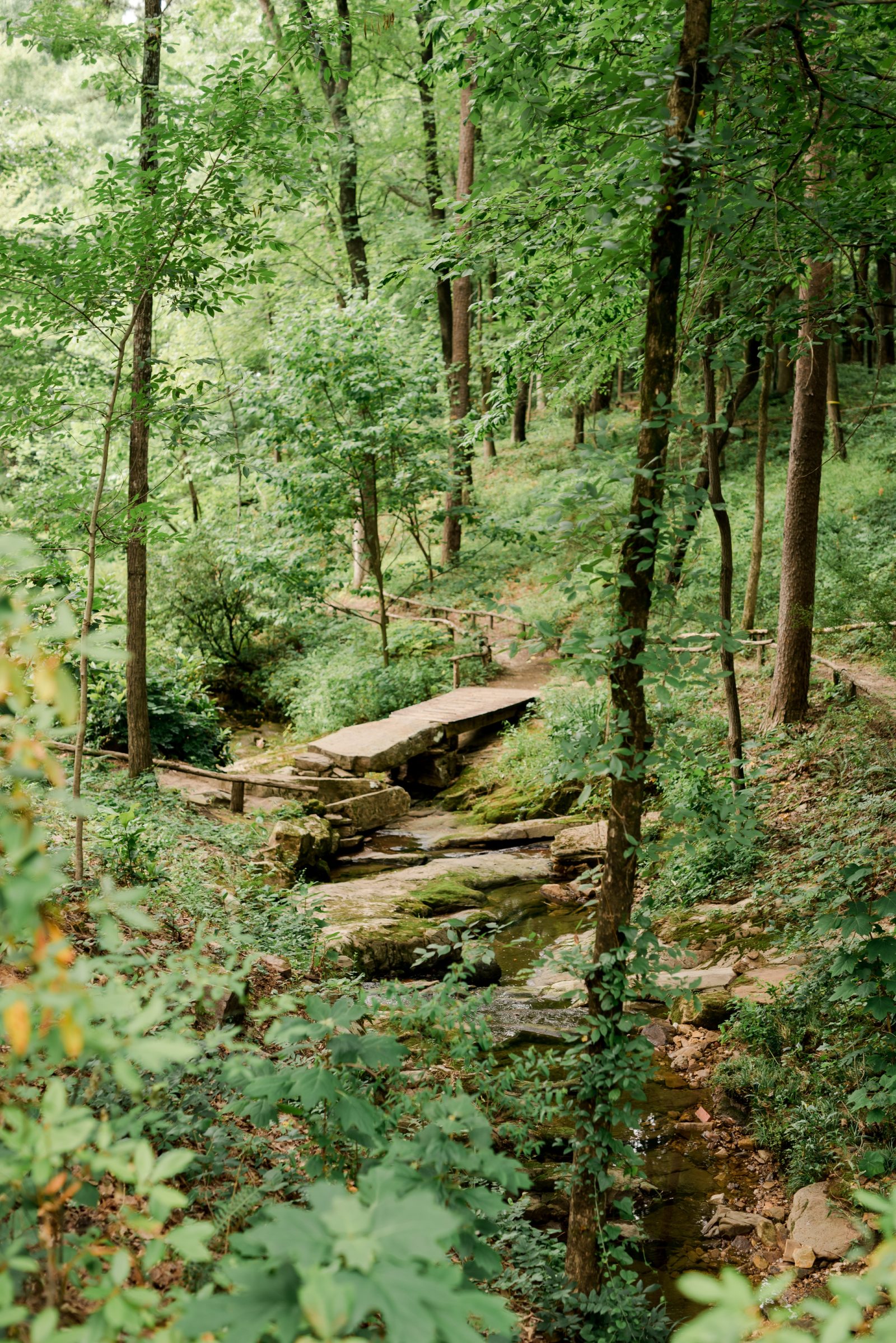
The view to the eastern-facing slope in its first growing season after Florida arise was removed.
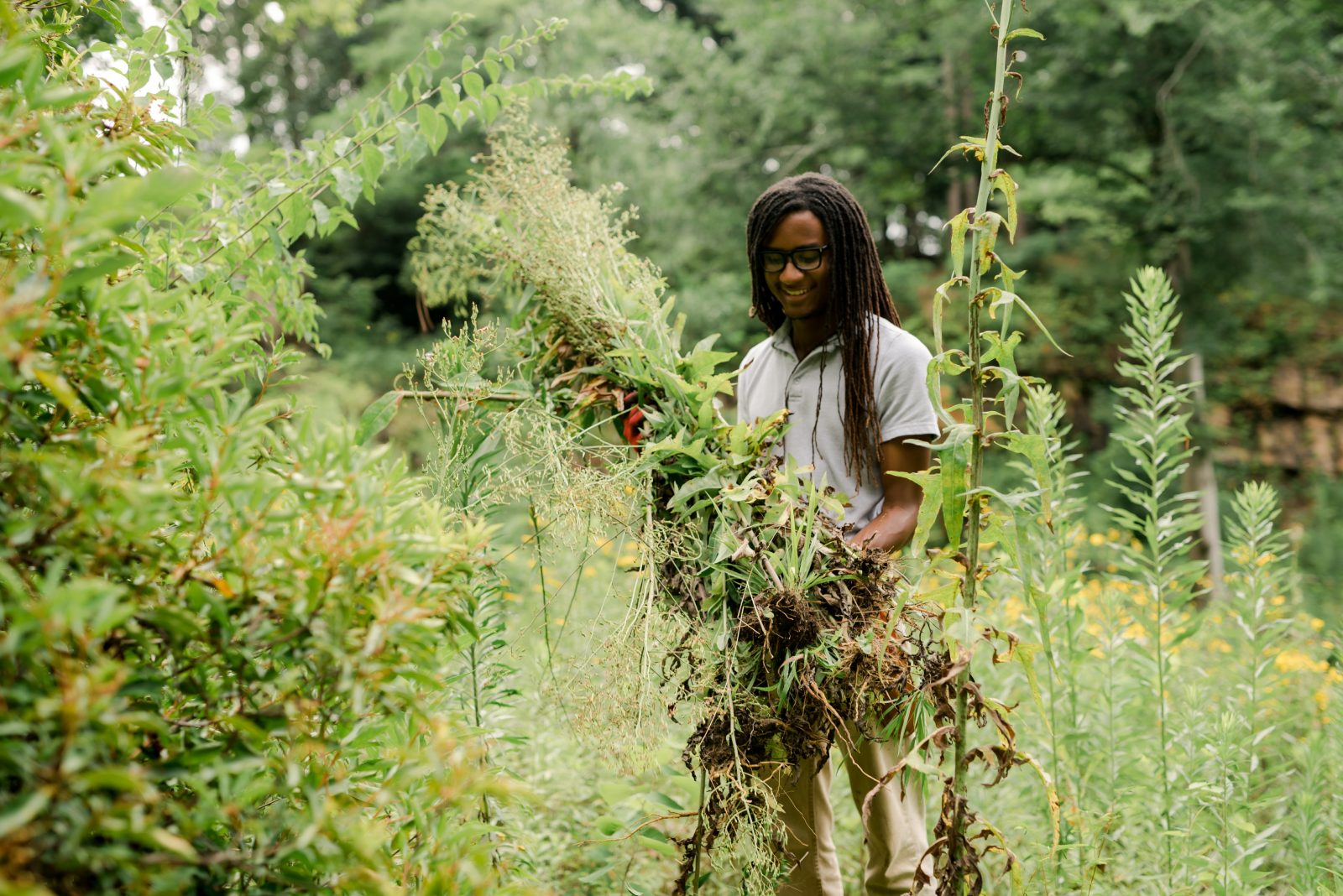
McCray tackles overgrowth.
It’s mid-April as I stand in Kaul with a bound copy of Rainer’s vision in hand. Spring is in full swing. Looking up into the eastern-facing forest slope we cleared this winter, we see a patchwork of spring ephemerals that are having a chance to shine in the absence of the Florida anise. Yellow trout lily blooms point their faces toward the sun, large stands of mayapples cover the ground, and trilliums I have never seen before weave throughout the unfurling fronds of ferns. “This is what Thomas was talking about,” I think to myself. The unapologetic editing did indeed yield new opportunities. It feels like a hopeful beginning.
Laying the Groundwork
Today Kaul is under the watchful eye of its third horticulturist, Keith Turney. In his first few months at the Gardens, Keith has shown his ability to see where the space currently is and tirelessly work toward setting the garden in motion to what it could be. For Keith, the Rainer plan is a living guidebook, a document meant to direct efforts while also being informed by a nuanced understanding of the site. That hard-fought knowledge of the garden has been a dance between clearing, observing, and responding. While Rainer provided a guiding framework, it is up to our team to make the on-theground decisions.
Today, it’s a sticky summer morning as I walk up to Kaul, where I find Keith suited up in his chaps with a chainsaw in hand. I am certain this means that some sweet gums have met their end. While Keith fires up the equipment, summer interns Truman and Mandrell grab their pickaxes and set to work on digging up smilax tubers, a special gardening task fondly referred to as “smilaxing.”
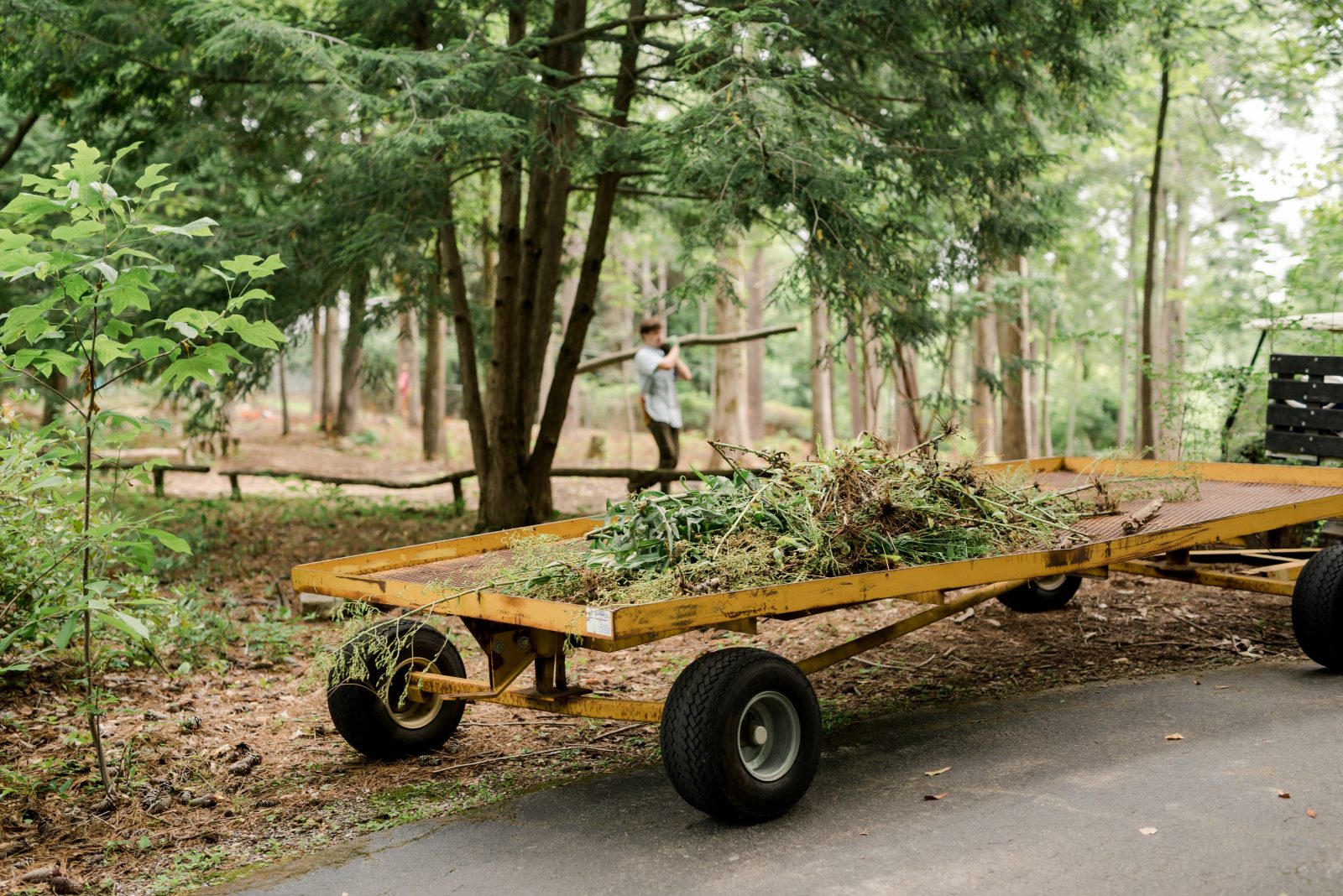
Summer intern Truman Douglass helps fill the yellow trailer with cleared debris.
Up until this past January, this northeastern corner of the garden was reminiscent of the scrubland that Bobbe Kaul and her comrades inherited at the very beginning of the garden’s creation. Along the upper ridgeline, towering cherry laurels and privet served as scaffolding for smilax and wisteria to climb into the upper reaches of higher canopy trees. When walking the upper path, it was impossible to see 3 feet beyond the edge. We knew to reclaim this area we would have to be aggressive, which led us to enlist Gray’s Tree Service to bring a forestry mulcher to clear the brush and open up this area. We discovered that beneath the grips of the scrubland was over an acre of ground shaded by the canopies of beautiful oaks, pines, and hickories. And as we learned on the forest slope, with all this editing we now had a space ripe for opportunity.
But what exactly this space was lending itself to, we weren’t quite sure. Week after week, Keith continued clearing with volunteers. And week by week, more parts of the garden revealed itself. Soon we realized the importance of knowing what we currently have in the garden before we can effectively design its future. One of our dedicated volunteers, Bob Koons, set to work mapping the current collection in Kaul down to every tree and shrub so that we can generate scaled maps to guide our efforts. As these hand-drawn maps are translated into AutoCAD, they reveal patterns in the existing collection and give us clues to what each area innately contributes.
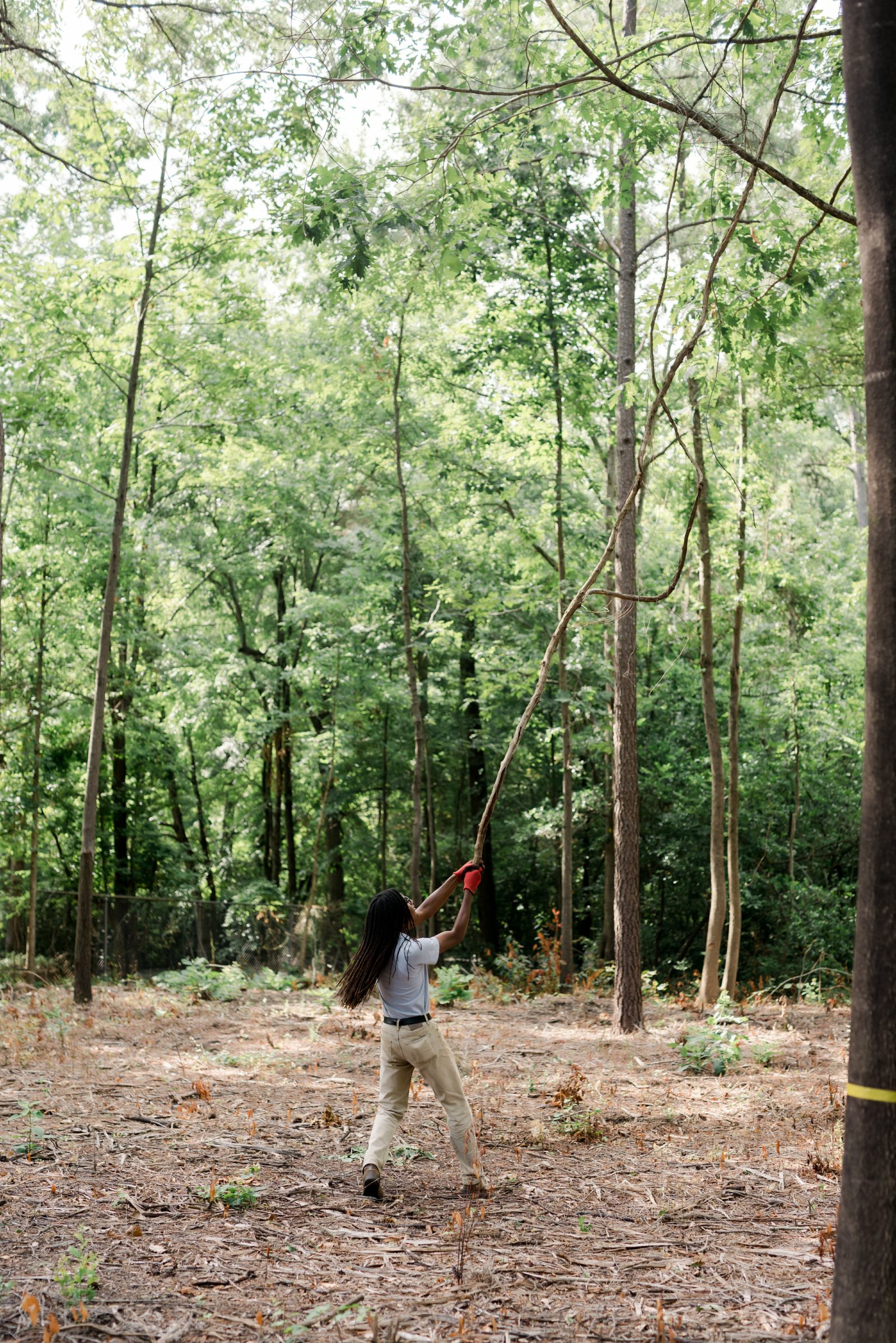
Intern Mandrell McCray tugs at a wisteria vine lodged in an oak tree.

A new dry creek bed constructed by volunteers will capture storm water and help prevent the erosion of paths.
As we studied the maps and walked and talked on-site, what emerged from these discussions was the idea of re-creating an oak-pine savannah in this upper corner of the garden, a landscape type that used to cover parts of our state but is now left only in remnants. Knowing the specific landscape we are aiming for guides every move, from how we clear, how we prep the soil, how we design, and how we ultimately will plant.
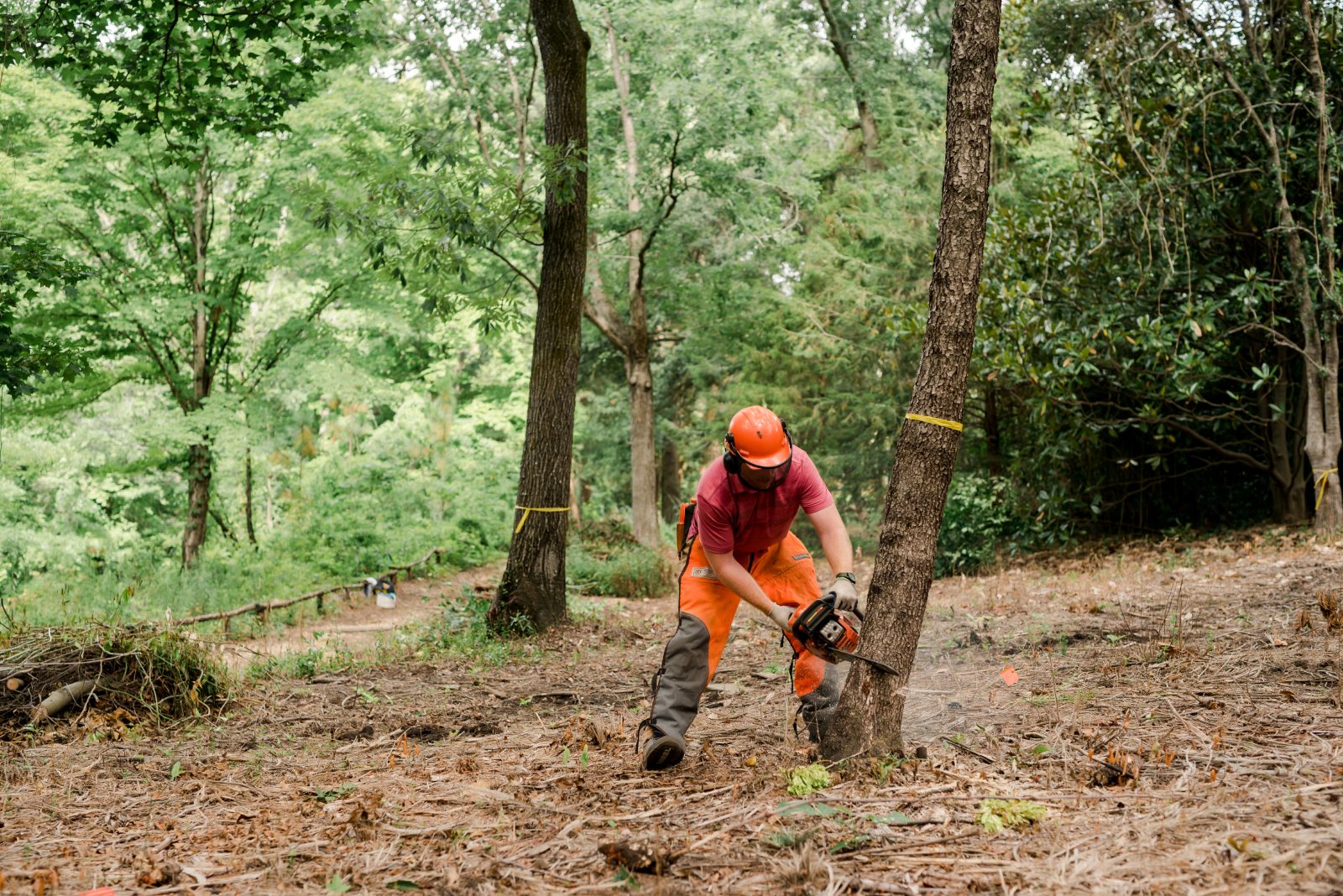
Kaul Wildflower Garden Horticulturist Keith Turney cuts down a sweetgum to make way for the oak-pine savannah. McCray declares victory over tenacious smilax tubers.
This summer is the time to prepare the ground for sowing a grassland seed mix in winter. Unwanted trees need to betaken down, stormwater needs addressed, weeds depleted from the soil, and smilax dug. It’s hard work. But Keith and his volunteers always keep that end goal in front of them. By the time I am leaving the garden, the crew has generated piles and piles of debris that will be taken to the compost pile by the Bobcat. Each pile is one step toward the future vision.
Dynamic Dialogue
The ongoing work in Kaul is a layered conversation. While many of our discussions happen in the field with work boots on, just as many happen back in the office, as we research the vast flora of our state to understand all the variables at play. We want our default posture to be curiosity. As we endeavor to answer a question, we can count on several new ones rising to the surface. So naturally, the walls of our office are taped with large sheets of butcher paper outlining ideas, plant species, maintenance tactics, and questions … lots and lots of questions.
The seasons are once again changing as Keith and I stand in front of yet another blank piece of butcher paper stuck to the wall. We have just come in from the garden where the asters are in bloom among the cardinal flowers and a host of bright sunflowers. But for this discussion, we can’t be distracted by autumn; we must take into account the full arc of the seasons.
I pick out an apricot-colored marker as we begin discussing which species should make up the central meadow at the heart of the garden. This meadow will be woven into the fabric of the Hartselle sandstone outcroppings at this low point in the garden.
“Coreopsis: What have you got?” Keith asks. I quickly jot down “coreopsis—tickseeds” on my paper. “There are more species than I thought!”
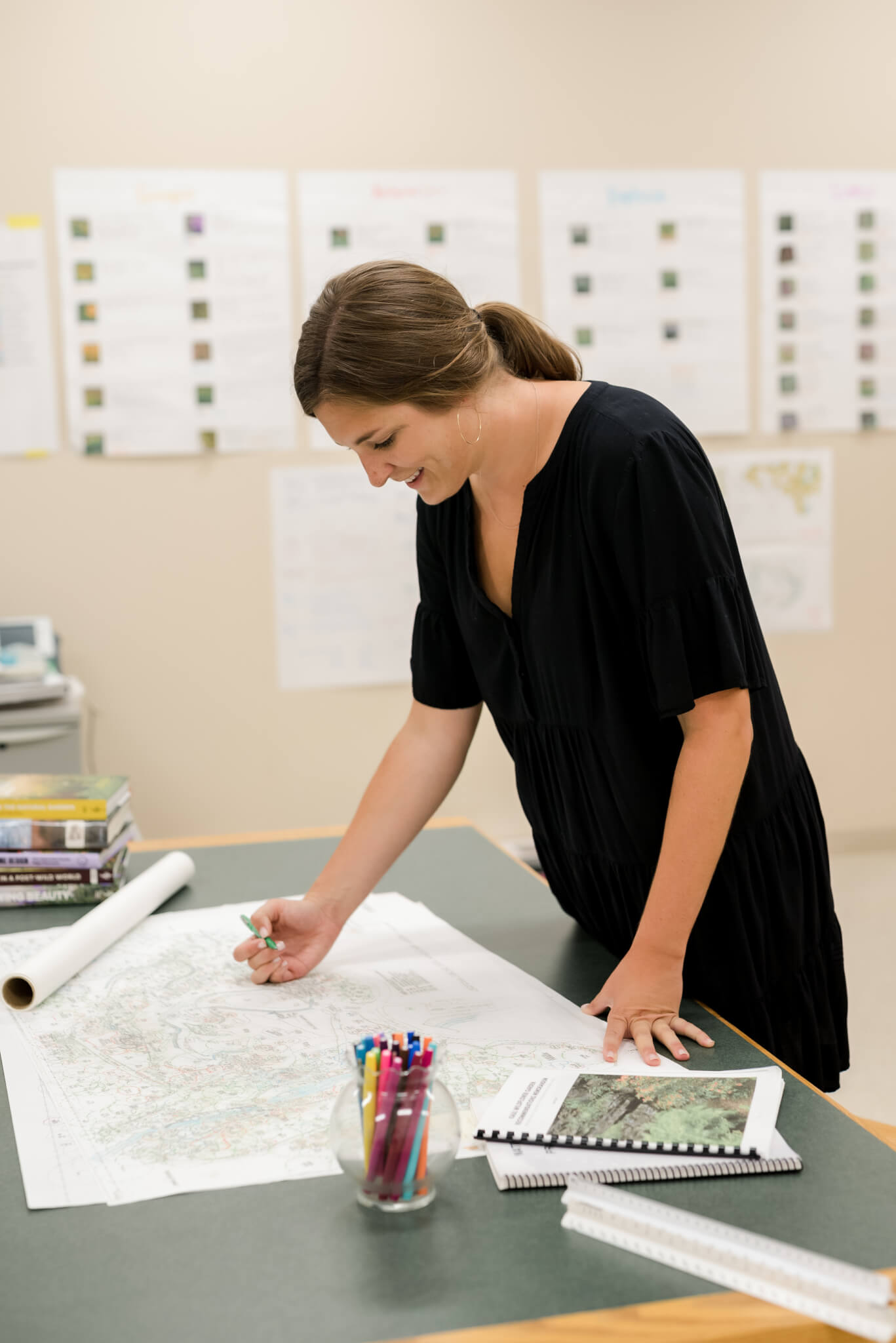
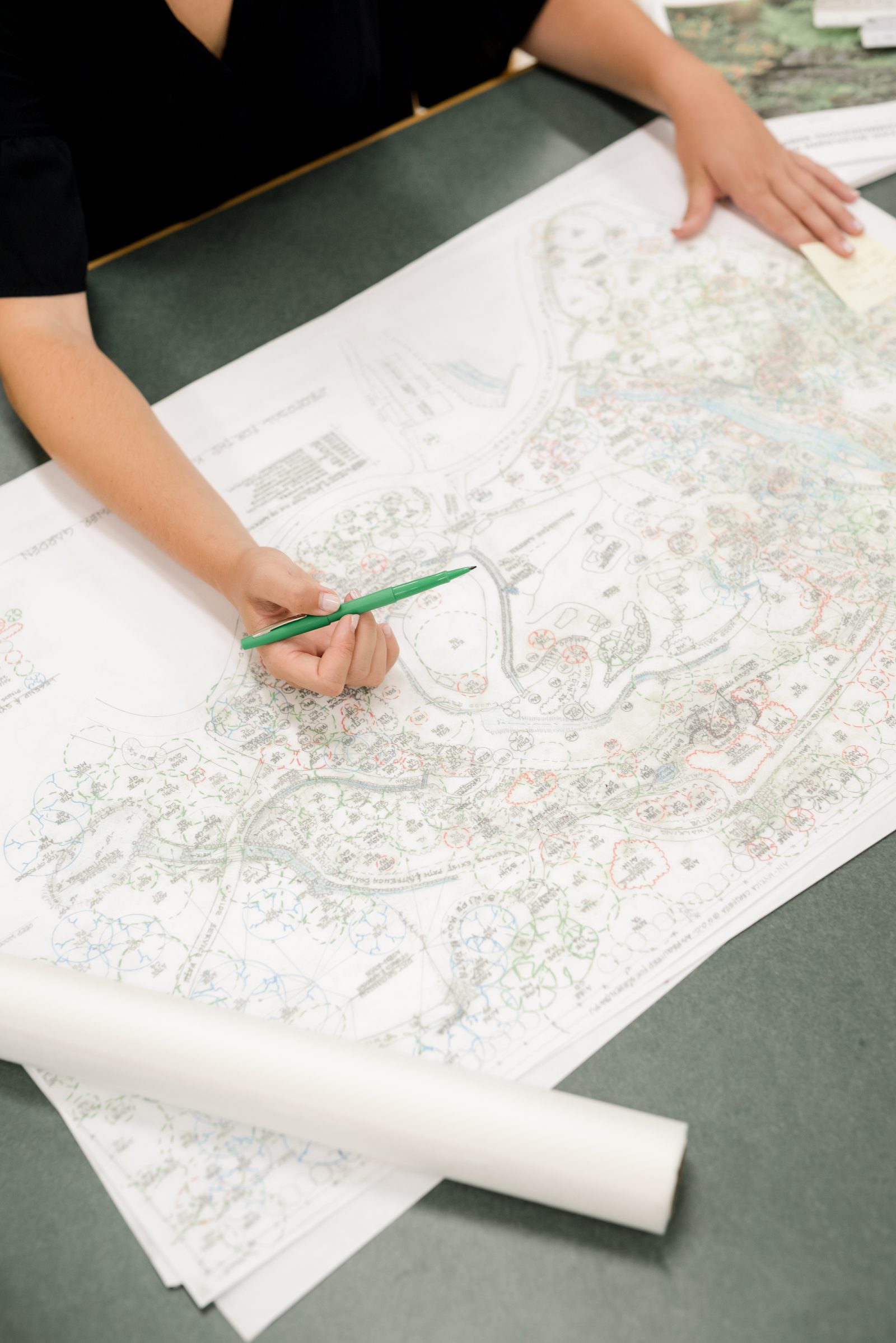
Molly Hendry reviews maps created to guide volunteer work and the garden’s future development.
I respond, grabbing my chart of the coreopsis found in Alabama. I can hear him clicking through the individual species of coreopsis on the Flora of Alabama database. “We know the species pulchra likes growing out there … is that the best one for the rocky bits of the meadow?” Keith responds.
And so it goes. Before we know it, my apricot marker has filled another block of paper with species names, combinations, colors, and bloom times. This chat is centered around what we are calling “plant recipes,” a term we coined to help us name the different plant communities that will fit into specific zones in the garden. We have dozens of plant recipes to work through with the goal of curating plant groupings that will respond to specific conditions on-site while also evoking a single wild reference point. Whether that is a forest slope, a moist woodland nook, or a dry rock outcropping in the blazing sun, we are never working from a blank slate. The wild places of the state are our map, and it is up to us to translate those wild plant associations into a garden setting.
Season by season, we continue our work. As the rush of the growing season slows and fall descends, we continue to hold that forward-thinking view of what Kaul can be. And perhaps that is what all gardens are: an ongoing dialogue between a person and a place, a conversation that can last a lifetime. And maybe, right here in the middle of the story, we discover our own kind of “happily ever after.” It’s happily ever becoming. And we are eager to have you with us for the journey.